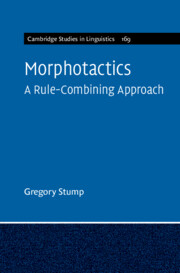Book contents
- Morphotactics
- Cambridge Studies in Linguistics
- Morphotactics
- Copyright page
- Dedication
- Contents
- Figures
- Tables
- Preface and Acknowledgments
- Abbreviations
- Symbols and Operators
- 1 Canonical Morphotactics
- 2 Rule Combinations
- 3 Dependent Rules and Carrier Rules
- 4 Rule Composition and Rule Ordering
- 5 Extending Canonical Morphotactic Criteria to Composite Rules
- 6 Rule Combinations Expressing Holistic Content
- 7 Rule Aggregation
- 8 Complex Morphotactic Interactions in Swahili
- 9 The Nonassociativity of Rule Composition in Murrinhpatha
- 10 Potentiation and Counterpotentiation
- 11 Rule Combinations and Morphological Simplicity
- 12 Rule‑combining Morphotactics and Morphological Theories
- 13 Conclusions
- References
- Index
3 - Dependent Rules and Carrier Rules
Published online by Cambridge University Press: 24 November 2022
- Morphotactics
- Cambridge Studies in Linguistics
- Morphotactics
- Copyright page
- Dedication
- Contents
- Figures
- Tables
- Preface and Acknowledgments
- Abbreviations
- Symbols and Operators
- 1 Canonical Morphotactics
- 2 Rule Combinations
- 3 Dependent Rules and Carrier Rules
- 4 Rule Composition and Rule Ordering
- 5 Extending Canonical Morphotactic Criteria to Composite Rules
- 6 Rule Combinations Expressing Holistic Content
- 7 Rule Aggregation
- 8 Complex Morphotactic Interactions in Swahili
- 9 The Nonassociativity of Rule Composition in Murrinhpatha
- 10 Potentiation and Counterpotentiation
- 11 Rule Combinations and Morphological Simplicity
- 12 Rule‑combining Morphotactics and Morphological Theories
- 13 Conclusions
- References
- Index
Summary
Rule composition makes it possible to model an important kind of deviation from the rule independence criterion – cases in which the application of one rule is directly dependent on that of another, carrier rule. In such cases, the only use of the dependent rule is as part of a composite rule incorporating both the dependent and its carrier. Where the definition of a word form involves two carrier rules, it can further happen that the same dependent rule composes with both of them, engendering a pattern of multiple exponence that deviates from the unique sequence criterion. I discuss two cases of this sort of rule dependency: Limbu verb morphology exhibits a pattern in which dependent rules compose with their carrier rules; Sanskrit presents a pattern of the reverse sort, in which a carrier rule composes with its dependent.
Keywords
- Type
- Chapter
- Information
- MorphotacticsA Rule-Combining Approach, pp. 83 - 112Publisher: Cambridge University PressPrint publication year: 2022

